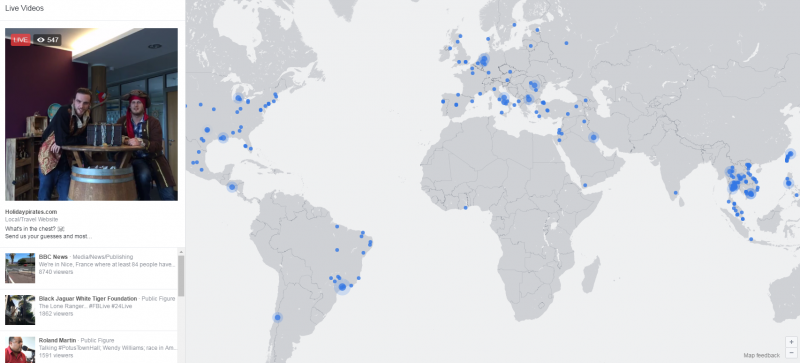Win Hearts and Minds With Livestreaming
Over the next few weeks US voters will focus on Hillary Clinton, Donald Trump, and their running mates at the Republican and Democratic National Conventions. Their messages will carry well beyond traditional TV with the help of livestreaming. The Republican National Convention in Cleveland will provide a 360 livestream. This will be one of the first high profile events streamed in 360 degrees. Twitter announced a deal with CBS to livestream the conventions whenever they are in session.

Image: Facebook Live has a map of every current live broadcast globally.
Live video can win hearts and minds. There’s a magic that surrounds live video and being able to experience an event with others as it happens. That magic is augmented by social integration that lets global viewers interact, converse, and share as if they’re on the same couch. Harness the power of live by starting small and experimenting. Whether you’re in healthcare, financial services, manufacturing, or retail, here are some interactive livestreaming ideas:
- Unveil a new product or service and tell your customers (or employees if internal) what it means and how it will help them.
- Choose a topical news item that relates to your industry and have a discussion about it with your company expert. Financial services could address market volatility, healthcare can talk about an outbreak, and so on.
- Make your leadership seem more approachable by having your CEO hold a weekly check in with employees or customers. These can be scripted or unscripted, but plan for interactivity by addressing questions or concerns.
What do Application Development and Delivery professionals need to consider when working on their live video technology strategy?
- Choose your platform wisely. YouTube, Facebook, Twitter, Ustream, and other platforms all offer free options to go live. Add in your own enterprise platform and the options can be confusing. If you a producing an internal company event, clearly you need to use your own enterprise platform for security. If you are producing a public event you could still use your own platform because it will give you rich analytics, the option for lead generation, and much stronger control over the content and the experience, but also consider Facebook. Its algorithm, while recently tweaked, favors live content and promotes it more heavily in the News Feed.
- Promote it appropriately. Most enterprise livestreaming platforms let you promote the stream with a splash screen that includes a countdown, registration options, social tools, etc. Instead of getting IT involved in this process, the platforms let you design a slick pre-show page without any development knowledge. These self service tools can now be used by marketing and corporate communications department. Make sure you email registrants shortly before you go live to drive them to the page.
- Keep your content alive. After a live event, don’t let the content die. Instead, make sure your livestream has a life as on demand content that can be accessed far beyond the event. For example, you can replay the entire livestream or slice it into shorter modules that can live on Facebook, YouTube, and your own portal. Ideally, you want the original livestream link to host the archived content so that it is easy for your viewers to find it later.
Is your company planning to do more with live video? How will you support it? Comment below or find me on Twitter.
